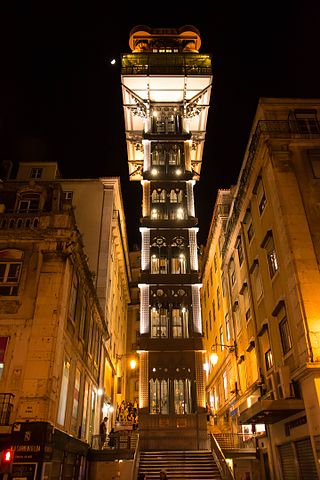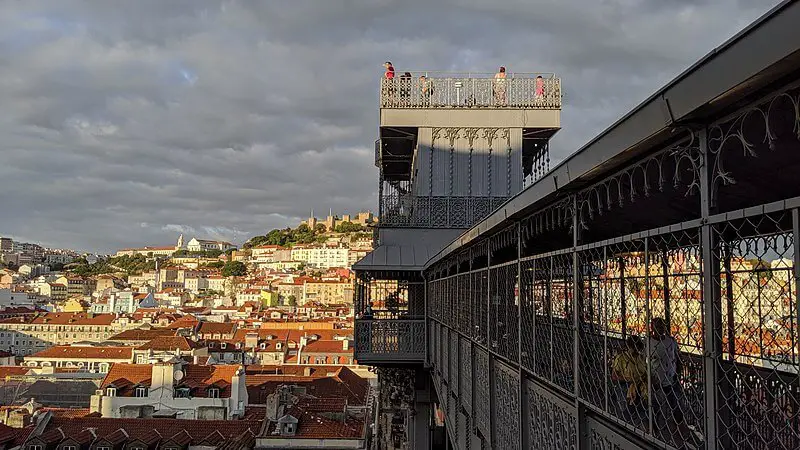Lisbon’s Santa Justa Lift, or in Portuguese – Elevador de Santa Justa – here is everything you need to know about one of the city’s most iconic sights to visit.

Elevador de Santa Justa – Background information
The neo-gothic elevator stands seven stories tall at 45 meters (148 feet).
It connects Lisbon’s lower downtown, Baixa, to Largo do Carmo on the adjacent hill.
Styled to resemble the neo-gothic Carmo Convent, the elevator has fantastic views of the convent, as well as nearby Rossio Square, the Alfama and Baixa neighborhoods, the São Jorge castle, and the Tejo River.
The Santa Justa Elevador was designed by Portuguese-born French engineer Raoul de Mesnier du Ponsard. He was an apprentice of Gustave Eiffel, which explains some of the elevator’s similarities with the Eiffel Tower.
The wrought-iron exterior of the Santa Justa Elevator is like a sculpture, combining its neo-gothic arches and geometric patterns.
The interior has two polished Brazil Wood benches, glass, and stylish brass work. Prior to covid, the elevator’s capacity was 35 – with 20 seats and 15 standing passengers.
The Santa Justa Lift was originally steam-powered when it opened to the public in 1902. It was converted to electricity in 1907. The elevator was restored and safety features were added in 2006.
When it was built at the beginning of the twentieth century, its purpose was to make life easier for residents who needed to move between the Baixa lowland and the hilltop neighborhoods of Santa Justa and Bairro Alto.
There was no easy way up the hill, and residents regularly used the elevator.
Today, like Tram 28, which also started as a practical way to get around town, the Santa Justa Lift is now more of a tourist attraction than a practical means of transportation.

Admission to the Santa Justa Elevator
A round-trip ticket for the Santa Justa elevator is €5.30.
However, if you purchase a 24-hour Viva Viagem transport card at the airport or in any metro station, for €6.40, your admission to the Santa Justa lift is included in that.
The 24-hour transport card also will pay for the trams and other cable cars and gives you unlimited use of the metro for 24 hours.
The 24-hour transport card does not include admission to the upper viewing deck of the Santa Justa Lift. That will set you back an extra €1.80, cash only.
Best and worst times to visit the Elevador de Santa Justa
Lines to visit the Elevador de Santa Justa can be very long, particularly from 12 pm – 3 pm.
The best time to visit is probably in the early evening as the sun begins to go down.
This provides the best light for photography, and a romantic moment as well.
Admission to the viewing platform is limited, so it will never be over-crowded (but there is a line for this too).
Skip the lines and the historic elevator
If you want to experience the viewing platform but skip the elevator, the admission fee, and the crowds at the bottom, you can access the viewing platform from behind the Carmo church. Cross the walkway, and then line up to climb the wrought-iron staircase to the viewing platform, paying only €1.80.
There is also a free modern elevator in one of the stores on Rua do Carmo which will take you up to a terrace bar just behind Largo do Carmo.
How to get to the Elevador de Santa Justa
Located in Lisbon’s “downtown” or Baixa District, the Elevador de Santa Justa lies in the center of a triangle formed by the Rossio Metro Station, the Terreiro Paço Metro Station, and the Baixa-Chiado Metro Station.
It is located near the popular Rua Augusta off of nearby Rua Áurea.
On the hilltop, the elevator can also be accessed from behind the Convento do Carmo church.
GPS: 38.71231849133742, -9.139472607962706
Other Attractions near the Santa Justa Lift
- Convento do Carmo – The church is one of Lisbon’s oldest remaining structures (1423), but was largely destroyed in the 1755 Lisbon Earthquake. Today you can appreciate the skeletal remains of the vaulted ceiling. Lisbon’s Convento do Carmo Ruins | Everything You Need to Know
- Praça do Comércio – Lisbon’s largest square was also the location of the royal palace prior to the 1755 earthquake. To learn more, read my Praça do Comércio – Everything you need to know
- Rua Augusta – A pedestrian boulevard lined with 18th-century buildings filled with cafes and shops. You will find lots of street performers here as well, and maybe a few harmless rogues trying to sell you drugs of dubious quality. At the end of the street, you will find the impressive Rua Augusta Arch. You can take an elevator to the top of the arch for outstanding views of the river and downtown. Learn more What is the story behind Lisbon’s Rua Augusta Arch?
- Rossio Square – Lisbon’s most famous square with its Portuguese tiled plaza. Surrounded by restaurants, cafes, and bookstores. It is also a hub of Lisbon’s subway system. Rossio Square – Praça Dom Pedro IV – What you need to know
- Praça da Figueira – The Rossio metro station has two entrances on opposite sides of the building – one on Rossio square and the other on Praça da Figueira. At Praça da Figueira you can find a farmer’s market and stops for trams and buses going all over the city. To learn more, see my article about Praça da Figueira
- São Domingos Church – Opened in 1241, the church has been damaged by multiple fires and earthquakes. The church was the seat of the Portuguese Inquisition, which saw the massacre of Lisbon’s Jewish population in 1506. Today the church is a meeting point for Lisbon’s African immigrants. To learn more, São Domingos Church in Lisbon
- Just off of the square you can find a tiny century-old shop (A Ginjinha) that sells €1 shots of Ginja – Portugal’s cherry liquor. As you stand in the doorway of the tiny establishment looking out, you can see one of the shop’s oldest competitors, Ginjinha Sem Rival, on Rua das Portas de Santo Antão. Your questions about Ginjinha answered here
- Rua das Portas de Santo Antão – Lots of options for places to eat.
- Rossio Train Station – A beautiful train station where you can connect to Portugal’s other cities. There is also a much-loved hostel on the top floor-of the train station. (Updated) Lisbon’s most interesting hotels (truly unique lodging in Lisbon)
- Restauradores Square – A busy square with a metro station and Hard Rock Cafe. You are also steps away from the Ascensor da Glória – a funicular that will take you up the hill to Bairro Alto and the São Pedro de Alcântara viewpoint.
- Avenida da Liberdade – A beautiful tree-lined boulevard with 18th century mansions, five star hotels, and high end shopping. Where to shop in Lisbon? Lisbon’s best malls and shopping
Lodging near the Santa Justa Lift
The Lift Boutique Hotel by Ridan
Rua Áurea 265
T: 351 211 165 766
The Lift Boutique Hotel offers a double room with breakfast included for $118.
Air-conditioned rooms have a safe and mini-bar.
The five-story hotel has an elevator and is located one minute away from the Elevador de Santa Justa, right in the middle of everything.
To book: https://www.booking.com/hotel/pt/the-lift-boutique.en.html?aid=7930224&no_rooms=1&group_adults=2
Rossio Plaza Hotel
Rua Áurea 266
T: 351 210 533 970
Also located steps from the Santa Justa lift, the Rossio Plaza Hotel has a great central location. A three-star hotel offering buffet and continental breakfast, as well as concierge service, air-conditioned double rooms are available for $148 per night.
To book: https://www.booking.com/hotel/pt/rossio-plaza.en.html?aid=7930224&no_rooms=1&group_adults=2
Golden Tram 242 Lisbon Hostel
Rua Áurea 244
T: 351 213 229 100
E: goldentram242lisbonnehostel@gmail.com
Offering 10-bed, 8-bed, and 4-bed mixed dorms, and female dorms starting at $18 a night.
All rooms have city views and there is a free buffet breakfast.
Golden Tram Lisbon Hostel also offers private rooms with flat-screen TVs and a mini fridge for $61 per night.
The hostel is located just one minute from the Santa Justa Lift and is well located for public transport in the heart of the Baixa District.
Thank you for reading this article. If you book a hotel through this page, I may receive a commission, but it will not affect the price that you pay. Prices may vary over time.